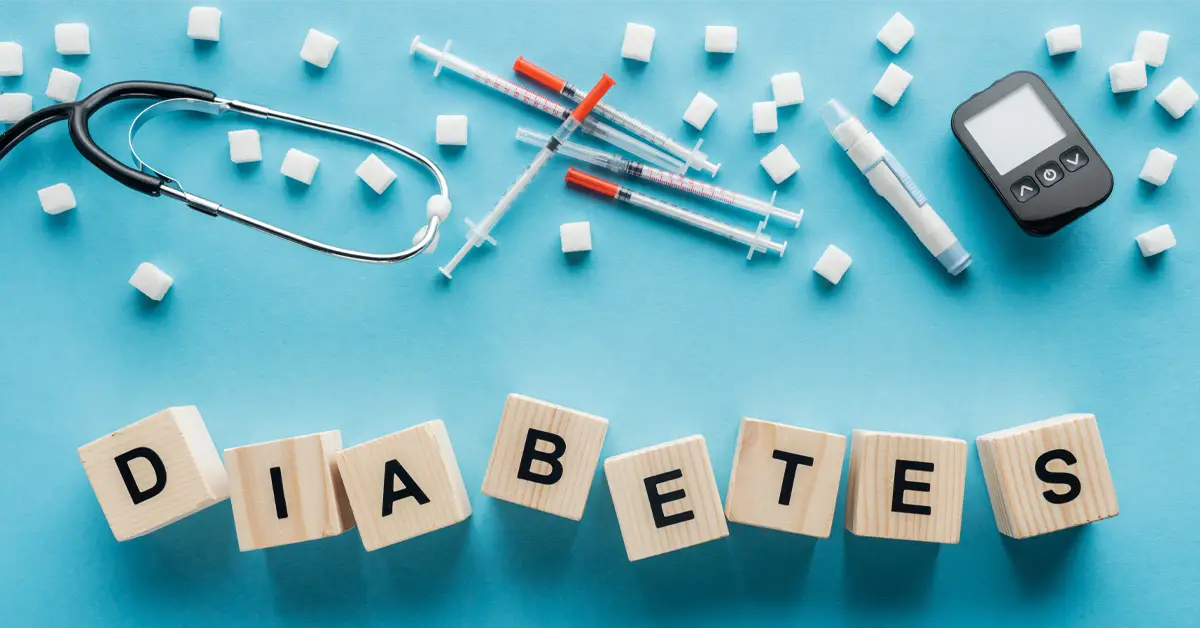Diabetes is a condition that affects how the body processes sugar (glucose) in the blood. There are two main types: type 1 and type 2.
Type 1 diabetes is an autoimmune disorder. The immune system attacks cells in the pancreas that produce insulin. Insulin is a hormone that helps regulate blood sugar levels. People with type 1 diabetes do not produce insulin and must use injections or an insulin pump to manage their blood sugar.
Type 2 diabetes is the most common form. It is caused by a combination of insulin resistance and a lack of insulin production. Insulin resistance occurs when cells in the body do not respond properly to insulin, leading to high blood sugar levels. Over time, the pancreas may not be able to produce enough insulin. People with type 2 diabetes may be able to manage their blood sugar with lifestyle changes or may need oral medications or insulin injections.
This article compares type 1 and type 2 diabetes, including their causes, symptoms, diagnosis, treatments, and long-term effects. Understanding the differences between these types of diabetes can help patients manage their condition and improve their overall health.
Causes of Type 1 and Type 2 Diabetes
The causes of type 1 and type 2 diabetes are quite different. Here is a summary of the main causes of each type of diabetes:
Type 1 diabetes:
- An autoimmune disorder that destroys insulin-producing cells in the pancreas.
- Genetically determined, but environmental factors may also play a role.
- Not caused by diet or lifestyle factors.
Type 2 diabetes:
- Caused by a combination of insulin resistance and a lack of insulin production.
- Often associated with obesity, physical inactivity, and unhealthy diet, but can also occur in people who are not overweight or inactive.
- Some people are more at risk for developing type 2 diabetes due to genetic factors, but lifestyle choices can also play a role.
In both type 1 and type 2 diabetes, the result is high blood sugar levels, which can lead to serious health complications if not properly managed.
Risk Factors for Type 1 and Type 2 Diabetes
There are several risk factors that can increase a person’s risk of developing type 1 or type 2 diabetes. It is important to be aware of these risk factors and to speak with a healthcare provider about any concerns you may have.
Risk factors for type 1 diabetes include:
- Family history of type 1 diabetes.
- Certain genetic markers, such as HLA-DR3 and HLA-DR4.
- Environmental factors, such as exposure to certain viruses.
Risk factors for type 2 diabetes include:
- Family history of type 2 diabetes.
- Obesity.
- Physical inactivity.
- Unhealthy diet.
- Age (risk increases with age).
- High blood pressure.
- High cholesterol.
- Polycystic ovary syndrome (PCOS).
- Previous gestational diabetes or delivery of a baby weighing more than 9 pounds.
- Certain racial and ethnic groups, such as African Americans, Hispanic Americans, Native Americans, and Asian Americans, are at higher risk for type 2 diabetes.
While these risk factors do not guarantee that a person will develop type 1 or type 2 diabetes, they may increase the likelihood of developing the disease.
Symptoms of Type 1 and Type 2 Diabetes
Both type 1 and type 2 diabetes can cause similar symptoms, including increased thirst, frequent urination, fatigue, blurred vision, and slow healing of cuts and wounds. However, the severity and onset of these symptoms may differ between the two types of diabetes.
Type 1 diabetes may present with more severe symptoms and rapid onset, often developing over a few weeks or even days. Symptoms may include:
- Extreme thirst and frequent urination
- Extreme hunger
- Rapid weight loss
- Dry mouth and itchy skin
- Blurred vision
- Fatigue and irritability
Type 2 diabetes may have more subtle symptoms that develop gradually over time. Symptoms may include:
- Increased thirst and frequent urination
- Dry mouth and itchy skin
- Blurred vision
- Slow healing of cuts and wounds
- Numbness or tingling in the hands and feet
It is important to note that some people with type 2 diabetes may not experience any symptoms at all in the early stages of the disease. This is one reason why it is important for people at risk of type 2 diabetes to get regular medical check-ups and blood sugar testing.
If you experience any of these symptoms, it is important to speak with your healthcare provider to determine the cause and receive proper treatment.
Diagnosis of Type 1 and Type 2 Diabetes
There are several tests that can be used to diagnose type 1 and type 2 diabetes. These tests measure the levels of glucose in the blood and can help determine whether someone has diabetes and, if so, what type.
The most common tests for diagnosing both types of diabetes include:
- Fasting blood glucose test: This test measures the levels of glucose in the blood after an overnight fast. A blood glucose level of 126 mg/dL or higher on two separate occasions indicates diabetes.
- Oral glucose tolerance test: This test measures the body’s ability to process glucose after drinking a sweet solution. A blood glucose level of 200 mg/dL or higher two hours after the test indicates diabetes.
- A1C test: This test measures the average blood glucose level over the past two to three months by measuring the amount of glucose that has attached to red blood cells. An A1C level of 6.5% or higher indicates diabetes.
While these tests are used to diagnose both types of diabetes, there are some differences in the diagnostic criteria for type 1 and type 2 diabetes.
Type 1 diabetes is typically diagnosed in younger individuals and requires multiple blood tests to confirm the diagnosis. If a person has high blood sugar levels and the symptoms of diabetes, their healthcare provider may perform additional tests, such as an autoimmune antibodies test or a C-peptide test, to confirm the diagnosis of type 1 diabetes.
Type 2 diabetes can be diagnosed with a single blood test in some cases, especially if the person is experiencing symptoms of diabetes or has risk factors for the disease. However, in some cases, multiple blood tests may be needed to confirm the diagnosis.
It is important to receive a proper diagnosis of diabetes from a qualified healthcare provider to ensure that you receive the appropriate treatment and care for your specific type of diabetes.
Treatments for Type 1 and Type 2 Diabetes
The treatment of type 1 and type 2 diabetes involves managing blood sugar levels to prevent complications and improve overall health. The main treatments for each type of diabetes are as follows:
Type 1 diabetes:
- Insulin therapy: People with type 1 diabetes do not produce insulin and must take insulin injections or use an insulin pump to manage their blood sugar levels. The type, dose, and frequency of insulin injections will depend on a variety of factors, including blood sugar levels, meal patterns, and physical activity.
- Blood sugar monitoring: Regular monitoring of blood sugar levels can help people with type 1 diabetes adjust their insulin doses and make adjustments to their diet and exercise routine as needed.
- Lifestyle changes: Making healthy lifestyle choices, such as following a healthy diet and getting regular exercise, can help people with type 1 diabetes manage their blood sugar levels and prevent complications.
Type 2 diabetes:
- Insulin therapy: Some people with type 2 diabetes may eventually need insulin injections or an insulin pump to manage their blood sugar levels. The decision to start insulin therapy will depend on a variety of factors, including the severity of diabetes and the effectiveness of other treatments.
- Oral medications: There are several types of oral medications that can help people with type 2 diabetes manage their blood sugar levels. These medications work by increasing the production of insulin, improving the body’s sensitivity to insulin, or slowing the absorption of glucose from the digestive tract.
- Blood sugar monitoring: Regular monitoring of blood sugar levels can help people with type 2 diabetes adjust their medications and make adjustments to their diet and exercise routine as needed.
- Lifestyle changes: Making healthy lifestyle choices, such as following a healthy diet and getting regular exercise, can help people with type 2 diabetes manage their blood sugar levels and prevent complications.
It is important to work with a healthcare provider to develop a treatment plan that is appropriate for your specific type of diabetes and individual needs.
Long-term Effects and Complications of Type 1 and Type 2 Diabetes
Both type 1 and type 2 diabetes can lead to serious complications if not properly managed. These complications can affect the cardiovascular system, nervous system, kidneys, and eyes. Some potential complications include: ·
- Heart attacks, strokes, and other cardiovascular problems
- Nerve damage that affects sensation and movement
- Kidney damage that can lead to kidney failure
- Vision loss or blindness
Type 1 diabetes may have a more severe and rapid onset of complications due to the sudden loss of insulin production. Proper management with insulin therapy and a healthy lifestyle can help prevent or delay complications. Type 2 diabetes may have a slower progression, but the risk of complications increases the longer a person has the disease. Proper management with medications, insulin therapy, and a healthy lifestyle can help prevent or delay complications.
Regular check-ups and blood sugar monitoring are important to detect potential problems early and receive appropriate treatment.
DrKumo’s Remote Patient Monitoring Technology for Diabetes Management
Remote patient monitoring (RPM) is a healthcare delivery model that allows patients to track and share their health data with their healthcare providers remotely, using digital technologies such as smartphones, tablets, or wearable devices.
DrKumo provides state-of-the-art RPM, which can be a useful tool for the management of diabetes, as it allows for continuous monitoring of blood sugar levels and other health parameters, as well as the ability to receive real-time feedback and support from healthcare providers.
Some of the benefits of DrKumo’s RPM for diabetes management include:
- Convenience: RPM allows patients to track their health data from the comfort of their own home, reducing the need for in-person visits to the healthcare provider.
- Enhanced communication: RPM enables patients to communicate with their healthcare providers remotely, providing the opportunity to ask questions and receive feedback on their health status.
- Improved blood sugar control: Regular monitoring of blood sugar levels through RPM can help patients adjust their treatment plans and make necessary changes to their diet, exercise routine, and stress management techniques to improve blood sugar control.
- Early detection of complications: RPM can help detect potential complications early, allowing patients to receive timely treatment and prevent further health problems.
Takeaways
Type 1 and type 2 diabetes are two different types of diabetes that affect the body’s ability to produce and use insulin. While both types of diabetes can cause similar symptoms and complications, they have different causes, diagnostic criteria, and treatment approaches. It is important for people with diabetes to receive a proper diagnosis and develop an appropriate treatment plan to manage their blood sugar levels and prevent complications.
RPM can be a useful tool for the management of diabetes, allowing patients to track and share their health data with their healthcare providers remotely and receive real-time feedback and support. By seeking medical advice and support, making healthy lifestyle choices, and using tools such as RPM, people with type 1 or type 2 diabetes can live healthy and active lives.
Speak with your healthcare provider about your treatment options, including the use of DrKumo’s RPM technology. Contact us for more information.
NOTE: The content in this article is not intended to be a substitute for professional medical advice, diagnosis, or treatment. Always seek the advice of your physician or other qualified health provider with any questions you may have regarding a medical condition.








